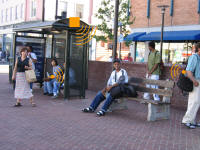
|
|
|
|
|
|
|
|
|
|
|
|
|
|
|
|
INFO
|
MOTIVATION |
|

|
Jabberwocky is a freely available mobile phone application designed to promote urban community connections and a sense of familiarity, anxiety, and play in public urban places. It takes advantage of current Bluetooth device proliferation. The application does not require seeding the population with initial users of the social network to function. Even today in most urban cities, the existence of even the current Bluetooth mobile phones is enough to gather meaningful and useful data for visualizations of place and urban strangers. Please check the
Official Familiar Stranger Research project website for the most
complete information on the motivation of this urban application. |
|
JABBERWOCKY APPLICATION |
|

|
The result of our studies on Familiar Strangers guided a design for a mobile phone application that would capture and extend the essence of the Familiar Stranger relationship. The tool is called Jabberwocky, named after Lewis Carroll’s famous nonsensical poem. These Jabberwockies can either be attached to fixed objects, such as a bus stop platform or used as a mobile phone application. Currently, only the mobile phone application is available for use. The principle metaphors of Jabberwockies are “digital scents” and “digital tagging”. As individuals traverse an urban landscape, they simply infuse their path with a unique and detectable digital redolence. Similarly, fixed places/objects can also emit unique “scents” once they are “digitally tagged” with small wireless tags called iMotes (these iMote devices have not been released for mass usage yet and thus the "digital tagging" hardware component of the Jabberwocky tool is still in development). These scents and tags are localized and can be implemented easily using many of today’s low power radios and personal wireless protocols such as Bluetooth. The Jabberwocky mobile phone application can be used with or without the deployment of the iMote hardware component. As two people approach one another, each person’s individually carried Jabberwocky mobile phone application transparently detects and records the other’s unique identity. In fact the beauty of the application is that it still operates even if the other Bluetooth mobile phone is not running the Jabberwocky application. Over time each Jabberwocky application accumulates a log of unique entries of people that have been previously encountered. Later, as the user crosses through another part of the city, takes the subway, or waits at a street corner, the Jabberwocky application senses nearby groups and crows and renders an abstract real-time visualization of familiarity. It is able to account for the amount of Familiar Strangers nearby as well as a notion of your shared history with them. This visualization provides an interface to groups and crowds rather than individuals, thus avoiding numerous privacy issues. In fact there is a freely available Jabberwocky application available for download and install on numerous modern mobile phones. This application is capable of operating without the use of the digital tags. Users of such phone can simply download the application to their mobile phone and begin to experience a new view of their urban life. |
|
YOUR URBAN NETWORK OF STRANGERS |
|
%20231_small.jpg)
|
The application works in two primary forms. Users of the Jabberwocky application are able to visualize current and historical Familiar Strangers and places using collections of Bluetooth addresses. Importantly, other users do not need to be using the application The tool is entirely capable of detecting other Bluetooth mobile phone users even those not using the Jabberwocky application. The actual installation and use of the Jabberwocky application is very straightforward. Users with MIPD2.0 (Mobile Information Device Profile) enabled mobile phones can download and install the freely available Jabberwocky application. The important point is that many new mobile phones being released by Nokia, Sony-Ericsson, Motorola, and others support this device profile. The application is free and open for use by everyone. The application has been used on numerous city streets, cafes, airports, train stations, subways, freeways, parks, and other urban spaces – each time collecting and building the social fabric of our Familiar Strangers. The Jabberwocky project
predates, but is clearly related to the phenomena of Toothing (using
Bluetooth mobile phones to flirt and arrange for sexual encounters) and
Bluejacking (sending anonymous messages to nearby individuals). |
Urban Atmospheres at Intel Research

%20102_small.jpg)
%20039_small.jpg)
%20222_small.jpg)
%20236_small.jpg)
%20125_small.jpg)
%20240_small.jpg)
%20181_small.jpg)